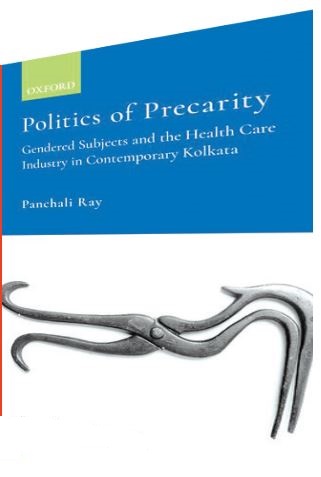 Politics of precarity: Gendered subjects and the health care industry in contemporary Kolkata
Politics of precarity: Gendered subjects and the health care industry in contemporary Kolkata
Panchali Ray; Oxford University Press
Rs.1,250; Pages 260
– Mohan Rao (The Book Review)
The Covid-19 pandemic is here to stay and we have to learn to live with it. In addition to the many things the pandemic has exposed — neglect of public health, disastrous implications of privatisation of healthcare, the lack of public health infrastructure and ignorance of the social roots of ill-health and disease — there’s the utter inadequacy of nursing and frontline staff. Overworked and underpaid, ASHA (Accredited Social Health Activist) workers in Karnataka, for instance, have been forced to call a strike. Even worse, these ‘warriors’ are expected to work long shifts without rest or proper protective equipment.
It’s in this context that Panchali Ray’s ethnographic work assumes great significance. This is a truly fascinating and well-written book that traverses disciplines and texts, and is marked by empathy towards her respondents. It’s multidisciplinary, exploring the lives of nurses in contemporary Kolkata.
It is based on studies of three sites in Kolkata, a government hospital, a private nursing home and private hospital. These are sites where it is difficult to gather data. The author has spent time with 100 healthcare workers, besides interviewing managers. Among the healthcare workers, the following strata were identified: registered nurses, private sisters, and attendants.
The historical continuity from colonial times is striking. Dr. Hilda Lazarus, the first Indian female in the Women’s Medical Service in 1917 spoke about the need for “good quality nurses, without whom healing is not possible… it was an art… that called for cultivated and cultured women from good families”. Nursing cannot be carried out by working class or lower caste women, like dais. As the author writes: “This was the heart of the ‘nurse problem’: devalued and stigmatised as menial, sexual, and servile labour, nursing was perceived as an occupation over-represented by women from lower-caste and/or working-class communities”.
At one time, it was believed that the professionalisation of nursing education would change things. But public health has been neglected in India, and a consequence has been nursing education. The lack of jobs for trained nurses in India is matched by the plethora of jobs abroad, as nurses’ migration to the rich countries assumes significance. At the same time, there has been phenomenal growth of nursing schools that churn out unregistered nurses for private sector hospitals, nursing homes and clinics, burgeoning in neo-liberal India.
Young women from desperately poor and predominantly lower caste families enter as unregistered nurses, working up to 14 hours per day, at appalling pay rates — less than the minimum wage for manual labour. Unsurprisingly, none of them wants her children to enter this profession. Indeed many would themselves like to leave it, if they had other options.
A rung below the unregistered nurses are the ‘private sisters’ and attendants, who earn even less under more exploitative working conditions. A private sister earns around Rs.3,300 per month if she works 30 days, while an attendant averages Rs.2,200-2,400. An important revelation is that the nursing community itself deploys strategies to “exclude social groups based on existing inequalities such as caste and gender,” writes Ray. Thus nursing labour is split between the medical and the manual with the latter often stigmatised for “breaching caste norms that cause a lot of anxiety and conflict,” says the author, who argues that “not just the Dalit but even the upper-caste but impoverished woman compelled to work in a ‘dirty occupation’ is considered contaminated, impure and the despicable other”.
The issues here — of caste and gender discrimination — are not unique to nursing. Payal Tadvis’ suicide (2019) tells us how pervasive this is among doctors. In an impressive chapter, Ray traces it to the patriarchal, hetero-normative families in which women are trained to be docile, accepting arranged marriages as their only option. To exercise this option Dalit women have to be submissive and unquestioning of social norms. To transgress would invite punishment, perhaps violent.
According to Ray, “stigma plays an important role in the devaluation of nursing labour; stigma is not an effect of devaluation but plays a constitutive role,” she writes. Thus, work involving attention to physical bodies and its effluents is despised as caste-based labour. Contributing to the stigma is the alleged sexual profligacy of lower caste women which requires surveillance and disciplining. Thus registered nurses are skilled, modest, austere bhadramahila while private nurses and sisters are dismissed as unskilled, primitive and loud chotamahila. But all the nurses interviewed insisted they were not doing “bad work”, sexual or immoral.
It is not surprising that given the precarious and uncertain nature of their employment, other than registered nurses in government hospitals, nurses have not been able to unionise. Indeed, the Nursing Council of India itself disapproves of unionisation. How, then, is this precariat to fight for overhaul of working conditions and pay?
I have one cavil: there is no description of the structure of medical care in Kolkata, and how this has changed since India took the neo-liberal turn in 1991. Nevertheless, this commendable book must be compulsory reading not just for those interested in nursing education, but the medical fraternity as a whole, including doctors, hospitals and nursing homes managers. The book is also important for scholars of labour and gender studies. Panchali Ray deserves accolades for this valuable and eminently readable work, a labour of infinite love.


























